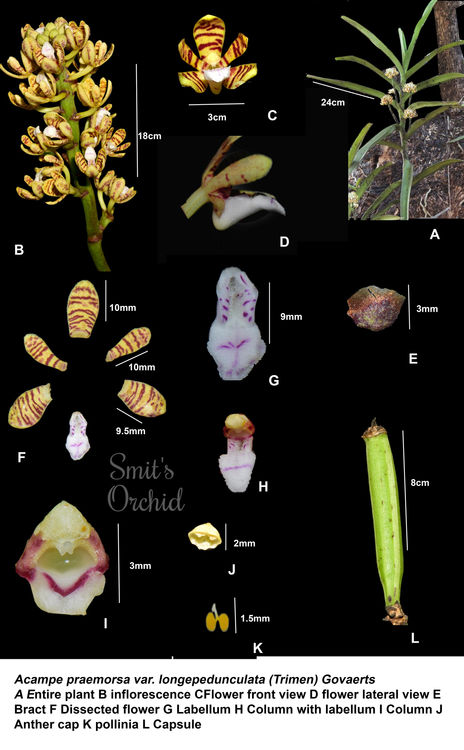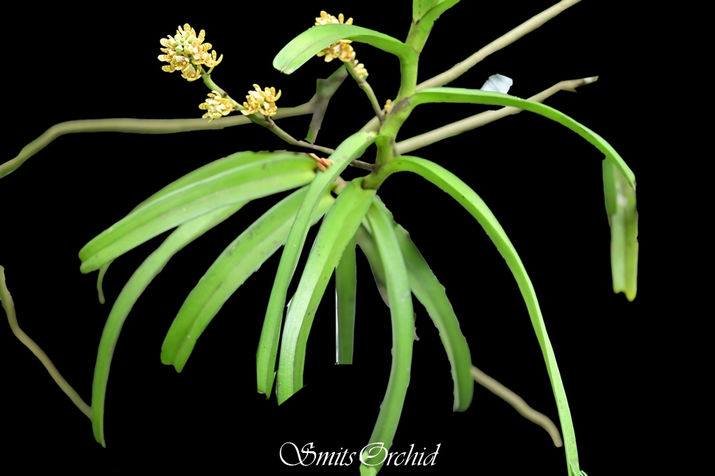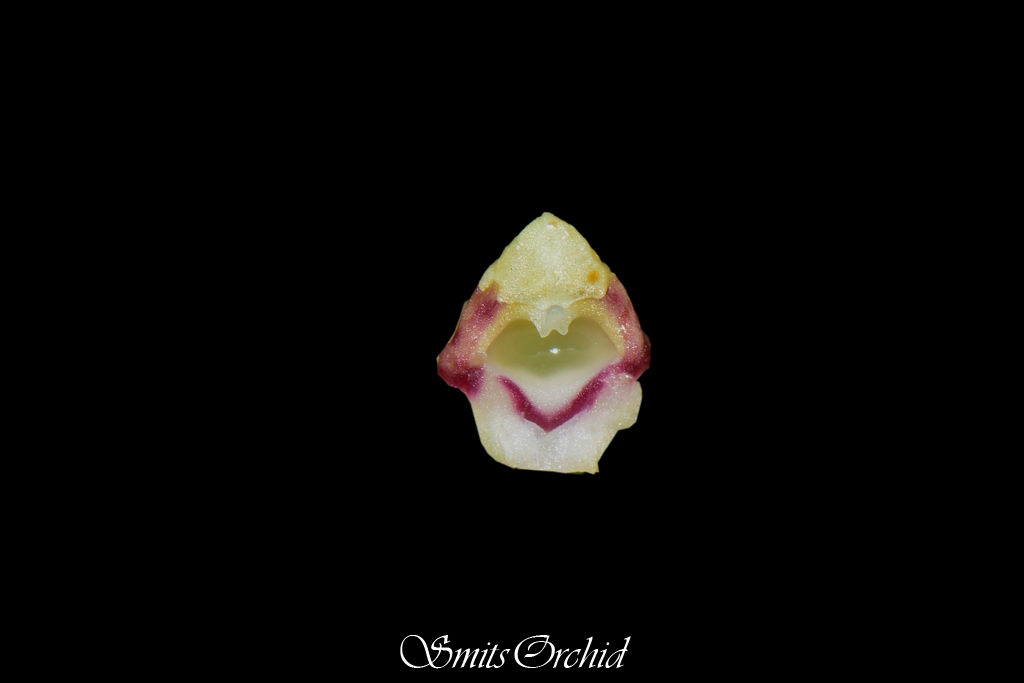
Acampe Lindl.
Sub Class Epidendroideae
Tribe Vandeae
Sub tribe Aeridinae
Derivation of name From the Greek akampes , stiff, rigid, probably in reference to the rigid, brittle flowers.
Salient Features
-
Coarse epiphytic or lithophytic herbs.
-
Stems simple or branched, stout, leafy.
-
Leaves distichous, conduplicate, coriaceous, sometimes fleshy, apex emarginate, bilobed or praemorse.
-
Inflorescence axillary, racemose, corymbose, or paniculate, shorter than leaves
-
Bracts inconspicuous, scale-like, persistent.
-
Flowers rigid and fleshy, fragile with the labellum nearest the inflorescence axis.
-
Sepals and petals similar, flat to curved; lateral sepals adnate to the spur when present
-
Labellum saccate or with a spur, adnate to column, immobile, rigid, variously lobed, fleshy, papillose, tuberculate or warty, some times dentate; spur lacking any internal tongue or median septum.
-
Column stout and fleshy, glabrous or papillose; stelidia two, tooth like; foot absent; anther cap ovate, apiculate; pollinia four, globose, unequal, waxy, connected in two pairs, caudicle linear, viscidium ovoid; stigma transverse, concave, rostellum emarginate.

Acampe praemorsa var. longipedunculata (Trimen) Govaerts
In Skvortsovia 4(3): 75 (2018)
-
Acampe wightiana var. longepedunculata Trimen in Syst. Cat. Fl. Pl. Ceylon: 90 (1885)
-
Acampe intermedia Rchb.f. in Allg. Gartenzeitung 24: 217 (1856)
-
Acampe longifolia (Lindl.) Lindl. in Fol. Orchid. 4: 1 (1853)
-
Acampe multiflora (Lindl.) Lindl. in Fol. Orchid. 4: 1 (1853)
-
Acampe penangiana Ridl. in J. Linn. Soc., Bot. 32: 358 (1896)
-
Acampe praemorsa var. rigida (Buch.-Ham. ex Sm.) Barbhuiya, D.Verma & Vik.Kumar in Phytotaxa 303(3): 274 (2017)
-
Acampe rigida (Buch.-Ham. ex Sm.) P.F.Hunt in Kew Bull. 24: 98 (1970)
-
Acampe taiwaniana S.S.Ying in Chin. Fl. 9: 30 (1974)
-
Aerides rigida Buch.-Ham. ex Sm. in A.Rees, Cycl. 39(1): n.° 12 (1818)
-
Gastrochilus longifolius (Lindl.) Kuntze in Revis. Gen. Pl. 2: 661 (1891)
-
Saccolabium longifolium (Lindl.) Hook.f. in Fl. Brit. India 6: 62 (1890)
-
Vanda longifolia Lindl. in Gen. Sp. Orchid. Pl.: 215 (1833)
-
Vanda multiflora Lindl. in Coll. Bot.: t. 38 (1826)
-
Vanda viminea Guillaumin in Bull. Soc. Bot. France 77: 336 (1930)

Ecology: Very common orchid at Sindhudurg district found growing as epiphyte on many trees such as Mangifera indica, Neolamarckia cadamba, Samanea saman Different species of Ficus, Syzygium & Terminalia & on lianas in semievergreen forest
Stem upto 1 m, stout, 8-20 mm in diam., unbranched, internodes 2-3 cm, with many distichous leaves.

Leaves distichous, leaf blade ascending, lorate, 17-40 × 3.5-5 cm, rather fleshy, amplexicaul-sheathing at base, apex obtuse and unequally bilobed.

Inflorescence axillary or opposite to leaf, usually from upper part of stem, suberect, 7-30 cm, unbranched or sometimes shortly branched, many flowered; peduncle 5-11 cm, 5-8 mm in diam., with 2 or 3 triangular sheaths.
Bracts broadly triangular, 3-5 mm, fleshy, obtuse.

Flowers somewhat fragrant, not opening widely, yellow with purplish brown transverse stripes, pedicel and ovary 1cm, yellowish green

Sepals and Petals similar, Golden yellow colored with purple colored strips.
Sepals similar, oblong, 10-12 × 5-6 mm, obtuse.

Petals 8-9 × 3-4 mm oblanceolate falcate, obtuse;

Labellum white, with purplish brown longitudinal stripes above thickly fleshy, 3-lobed; lateral lobes subquadrate; mid-lobe suberect, ovate-ligulate, 5-6 mm, margin slightly undulate and irregularly incised, apex obtuse, slightly recurved;
Spur conic, 3 mm, inside densely hairy, apex obtuse.

Column 2.5 mm, stout; Column foot absent Stellidia 2 tooth like;
Anther cap subspherical;
Pollinia 4, globose waxy unequal caudicle oblanceolate, ca. 1.2 mm; viscidium subovate.
Stigma ovate concave


Capsule suberect, cylindric or narrowly fusiform, ca. 6 cm × 8-15 mm.
Flowering: April to August
Fruiting: May onwards
























